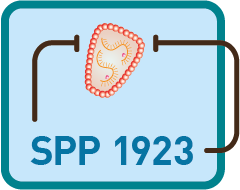Regulation of the induction of IFNα subtypes during HIV infection


Project Member

Prof. Dr. Ulf Dittmer
Project Leader
Prof. Dr. Ulf Dittmer
Phone: +49 201 723‑3696
Fax: +49 201 723‑6850
Ulf.Dittmer@uni-due.de
Institute of Virology
University Hospital Essen
Hufelandstr. 55
45122 Essen
Germany

Dr. Kathrin Sutter
Project Leader
Dr. Kathrin Sutter
(geb. Gibbert)
Phone: +49 201 723 – 83250
Fax: +49 201 723‑5995
Kathrin.Sutter@uni-due.de
Institute of Virology
University Hospital Essen
Hufelandstr. 55
45122 Essen
Germany

Prof. Dr. Barbara Sitek
Project Leader
Prof. Dr. Barbara Sitek
Phone: +49 234 32 – 24362
Fax: +49 234 32 – 14554
Barbara.Sitek@rub.de
Stellv. Institutsdirektorin
Medizinisches Proteom-Center
Department Clinical Proteomics
Universitätsstraße 150
Building ZKF 1.063
44801 Bochum
Germany

Zehra Karaköse,
PhD Student

Martha Ingola,
PhD Student
Project Summary
The gut-associated lymphoid tissue (GALT) is critical for the initial establishment and spread of HIV‑1 infection. It is currently thought that type I interferons (IFNs), induced during host innate immune responses by various pattern recognition receptors, play a key role in counteracting initial viral spread. Type I IFNs are induced in early HIV‑1 infection, and plasmacytoid dendritic cells, which produce type I IFNs in large quantities, are rapidly recruited to mucosal sites of infection. Type I IFNs likely inhibit HIV‑1 by increasing the expression and activity of restriction factors that directly inhibit HIV‑1 replication. The exact mechanisms underlying the anti-HIV activity of IFNα are not completely understood and are very complex because IFNα is comprised of 12 distinct subtypes that possess diverse biological properties. HIV infection of a target cell can be sensed by multiple pattern recognition receptors, which leads to the production of type I IFNs, but if certain sensing pathways are associated with specific IFNα subtype induction is unknown. We established the Lamina Propria Aggregate Culture (LPAC) model to characterize the induction of specific IFNα subtypes by HIV in mucosal lymphocytes. To precisely quantify IFNα subtype proteins in complex biological samples we will set up a unique mass spectrometry assay. Using a parallel reaction monitoring (PRM) mode the new assay should be able to measure protein concentrations of different IFNα subtypes in patient samples from acutely and chronically HIV-infected patients. Moreover a phospho proteomics studies will be performed to analyse the downstream signaling pathways triggered by IFNα subtypes during HIV infection. Beside the induction of IFNα subtypes we also want to characterize their individual signaling pathways and we will define the protein regions or single amino acids that are critical for the strong anti-HIV effects of certain IFNα subtypes. This project should provide new insights into how the induction of different type I IFNs and the activation of downstream signaling pathways may impact mucosal HIV‑1 infection and pathogenesis. These results shall help to develop strategies that aim to use specific IFNα subtypes or IFNα hybrids/mutants for immunotherapy against HIV infection.


